Chapter 10Bond Markets(金融市场学)
- 格式:ppt
- 大小:439.50 KB
- 文档页数:26
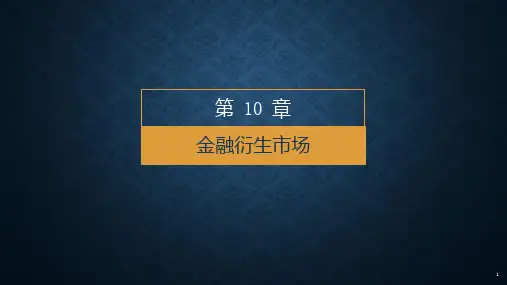
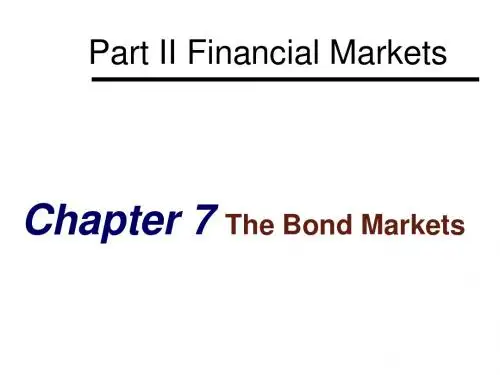


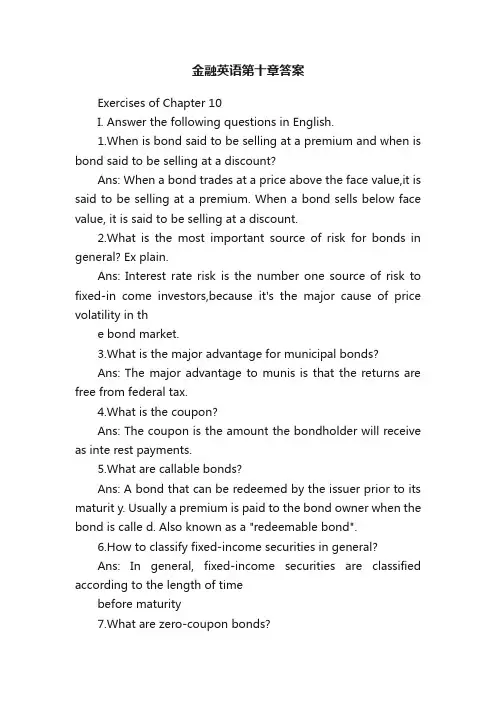
金融英语第十章答案Exercises of Chapter 10I. Answer the following questions in English.1.When is bond said to be selling at a premium and when is bond said to be selling at a discount?Ans: When a bond trades at a price above the face value,it is said to be selling at a premium. When a bond sells below face value, it is said to be selling at a discount.2.What is the most important source of risk for bonds in general? Ex plain.Ans: Interest rate risk is the number one source of risk to fixed-in come investors,because it's the major cause of price volatility in the bond market.3.What is the major advantage for municipal bonds?Ans: The major advantage to munis is that the returns are free from federal tax.4.What is the coupon?Ans: The coupon is the amount the bondholder will receive as inte rest payments.5.What are callable bonds?Ans: A bond that can be redeemed by the issuer prior to its maturit y. Usually a premium is paid to the bond owner when the bond is calle d. Also known as a "redeemable bond".6.How to classify fixed-income securities in general?Ans: In general, fixed-income securities are classified according to the length of timebefore maturity7.What are zero-coupon bonds?Ans: This is a type of bond that makes no coupon payments but instead is issued at aconsiderable discount to par value.8.What do bond brokers do for investors?Ans: A full service or discount brokerageⅡ. Fill in the each blank with an appropriate word o r expression.l. Interest Rate Risk is the number one source of risk to fixed-incom e investors,because it's the ( major )cause of price volatility in the bond market.2.In the ( case )of bonds, interest rate risk translates ( into ) marketrisk: The behavior of interest rate, in general, affects all bond s and cuts( across ) all sectors of the market-even the U.S. Treasury mar ket.3. When market interest rates rise, bond prices fall, and vice ver sa. And asinterest rates become more volatile,( so ) do bond prices.4. This is a type of bond that makes no coupon payments but( ins tead )isissued at a considerable discount to par value. For example, let's say a zero-coupon bond with a $1 000 par value and 10 years to maturity is( trading )at $ 600; you'd be paying $ 600 ( today )for a bond that wil l be worth$1 000 in 10 years.5. Bonds have a ( number )of characteristics of which youneed to be aware.All of these factors play a role in determining the value of a b ond and theextent to( which )it fits in your portfolio.6. In general, fixed-income securities are classified( according to )the length of timebefore maturity. These are the three main categories.III. Translate the following sentences into English.l.债券买卖是指交易双方以约定的价格买卖一定金额的债券并在规定的清算时间内办理债券款项交割的交易方式。
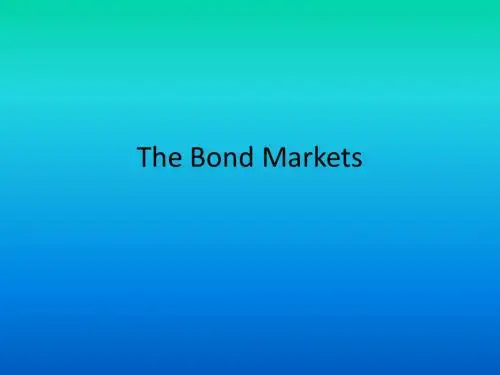
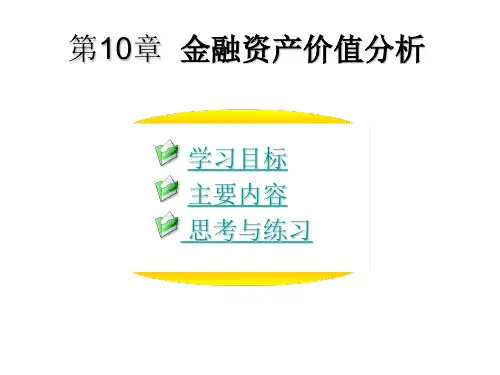
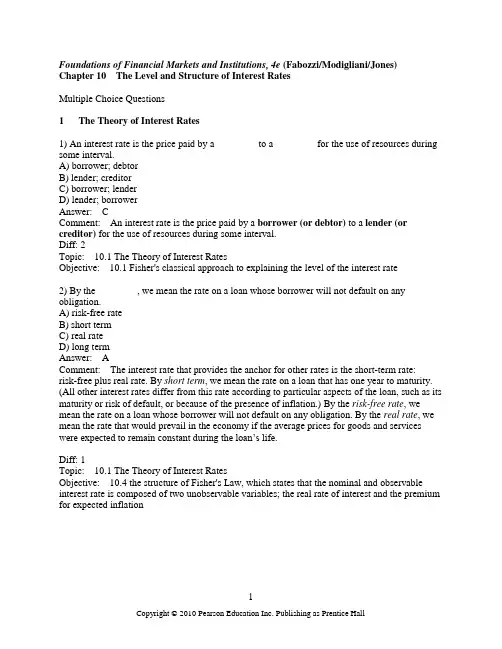
Foundations of Financial Markets and Institutions, 4e (Fabozzi/Modigliani/Jones)Chapter 10 The Level and Structure of Interest RatesMultiple Choice Questions1 The Theory of Interest Rates1) An interest rate is the price paid by a ________ to a ________ for the use of resources during some interval.A) borrower; debtorB) lender; creditorC) borrower; lenderD) lender; borrowerAnswer: CComment: An interest rate is the price paid by a borrower (or debtor) to a lender (or creditor) for the use of resources during some interval.Diff: 2Topic: 10.1 The Theory of Interest RatesObjective: 10.1 Fisher's classical approach to explaining the level of the interest rate2) By the ________, we mean the rate on a loan whose borrower will not default on any obligation.A) risk-free rateB) short termC) real rateD) long termAnswer: AComment: The interest rate that provides the anchor for other rates is the short-term rate:risk-free plus real rate. By short term, we mean the rate on a loan that has one year to maturity. (All other interest rates differ from this rate according to particular aspects of the loan, such as its maturity or risk of default, or because of the presence of inflation.) By the risk-free rate, we mean the rate on a loan whose borrower will not default on any obligation. By the real rate, we mean the rate that would prevail in the economy if the average prices for goods and services were expected to remain constant during the loan’s life.Diff: 1Topic: 10.1 The Theory of Interest RatesObjective: 10.4 the structure of Fisher's Law, which states that the nominal and observable interest rate is composed of two unobservable variables; the real rate of interest and the premium for expected inflation3) By the ________, we mean the rate that would prevail in the economy if the average prices for goods and services were expected to remain constant during the loan's life.A) risk-free rateB) short termC) real rateD) long termAnswer: CComment: The interest rate that provides the anchor for other rates is the short-term rate:risk-free plus real rate. By short term, we mean the rate on a loan that has one year to maturity. (All other interest rates differ from this rate according to particular aspects of the loan, such as its maturity or risk of default, or because of the presence of inflation.) By the risk-free rate, we mean the rate on a loan whose borrower will not default on any obligation. By the real rate, we mean the rate that would prevail in the economy if the average prices for goods and services were expected to remain constant during the loan’s life.Diff: 1Topic: 10.1 The Theory of Interest RatesObjective: 10.4 the structure of Fisher's Law, which states that the nominal and observable interest rate is composed of two unobservable variables; the real rate of interest and the premium for expected inflation4) By the ________, we mean the rate on a loan that has one year to maturity.A) risk-free rateB) short termC) real rateD) long termAnswer: BComment: The interest rate that provides the anchor for other rates is the short-term rate:risk-free plus real rate. By short term, we mean the rate on a loan that has one year to maturity. (All other interest rates differ from this rate according to particular aspects of the loan, such as its maturity or risk of default, or because of the presence of inflation.) By the risk-free rate, we mean the rate on a loan whose borrower will not default on any obligation. By the real rate, we mean the rate that would prevail in the economy if the average prices for goods and services were expected to remain constant during the loan’s life.Diff: 2Topic: 10.1 The Theory of Interest RatesObjective: 10.1 Fisher's classical approach to explaining the level of the interest rate5) Which of the below statements about consumptions and savings is FALSE?A) A chief influence on the saving decision is the individual's marginal rate of time preference, which is the willingness to trade some consumption now for more future consumption.B) Generally, higher current income means the person will save more, although people with the same income may have different time preferences.C) A variable affecting savings is the reward for saving, or the rate of interest on loans that savers make with their unconsumed income.D) The total savings (or the total supply of loans) available at any time is the sum of everybody's savings and a negative function of the interest rate.Answer: DComment: The total savings (or the total supply of loans) available at any time is the sum of everybody’s savings and a positive function of the interest rate.Diff: 2Topic: 10.1 The Theory of Interest RatesObjective: 10.2 the role in Fisher's theory of the saver's time preference and the borrowing firm's productivity of capital6) Which of the below statements about the rate of interest and cost of capital is FALSE?A) The maximum that a firm will invest depends on the rate of interest, which is the cost of loans; the firm will invest only as long as the marginal productivity of capital exceeds or equals the rate of interest.B) Firms will reject only projects whose gain is not less than their cost of financing.C) The firm's demand for borrowing is negatively related to the interest rate; if the rate is high, only limited borrowing and investment make sense.D) At a low rate of interest, more projects offer a profit, and the firm wants to borrow more; his negative relationship exists for each and all firms in the economy.Answer: BComment: The maximum that a firm will invest depends on the rate of interest, which is the cost of loans. The firm will invest only as long as the marginal productivity of capital exceeds or equals the rate of interest. In other words, firms will accept only projects whose gain is not less than their cost of financing. Thus, the firm’s demand for borrowing is negatively related to the interest rate. If the rate is high, only limited borrowing and investment make sense. At a low rate, more projects offer a profit, and the firm wants to borrow more. This negative relationship exists for each and all firms in the economy.Diff: 2Topic: 10.1 The Theory of Interest RatesObjective: 10.2 the role in Fisher's theory of the saver's time preference and the borrowing firm's productivity of capital7) The ________ rate of interest is determined by interaction of the supply and demand functions. As a cost of borrowing and a reward for lending, the rate must reach the point where total supply of savings ________ total demand for borrowing and investment.A) equilibrium; is greaterB) minimum; equalsC) equilibrium; equalsD) minimum; is greaterAnswer: CDiff: 2Topic: 10.1 The Theory of Interest RatesObjective: 10.3 the meaning of equilibrium and how changes in the demand and supply function affect the equilibrium level of the interest rate8) In the absence of inflation, the nominal rate ________ the real rate.A) equalsB) is greater thanC) is less thanD) greater than or equal toAnswer: ADiff: 1Topic: 10.1 The Theory of Interest RatesObjective: 10.3 the meaning of equilibrium and how changes in the demand and supply function affect the equilibrium level of the interest rate9) The relationship between inflation and interest rates is the well-known Fisher's Law, which can be expressed this way: (1 + i) = (1 + r) × (1 + i) where ________.A) r is the nominal rate.B) i is the real rate.C) p is the expected percentage change in the price level of goods and services over the loan's life.D) the nominal rate, p, reflects both the real rate and expected inflation.Answer: CComment: The relationship between inflation and interest rates is the well-known Fisher’s Law, which can be expressed this way: (1 + i) = (1 + r) × (1 + i) where i is the nominal rate, r is the real rate, and p is the expected percentage change in the price level of goods and services over the loan’s life. This equation shows that the nominal rate, i, reflects both the real rate and expected inflation.Diff: 2Topic: 10.1 The Theory of Interest RatesObjective: 10.4 the structure of Fisher's Law, which states that the nominal and observable interest rate is composed of two unobservable variables; the real rate of interest and the premium for expected inflation10) Which of the below IS considered by Fisher's theory.A) Fisher's theory takes into account the power of the government (in concert with depository institutions) to create money.B) Fisher's theory considers the government's often large demand for borrowed funds, which is frequently immune to the level of the interest rateC) Fisher's theory takes into account the possibility that individuals and firms might invest in cash balances.D) Fisher's theory considers an interest rate on loans that embodies no premium for default risk because borrowing firms are assumed to meet all obligations.Answer: DComment: Fisher’s theory is a general one and obviously neglects certain practical matters, such as the power of the government (in concert with depository institutions) to create money and the government’s often la rge demand for borrowed funds, which is frequently immune to the level of the interest rate. Also, Fisher’s theory does not consider the possibility that individuals and firms might invest in cash balances. Expanding Fisher’s theory to encompass these situations produces the loanable funds theory of interest rates.Diff: 2Topic: 10.1 The Theory of Interest RatesObjective: 10.4 the structure of Fisher's Law, which states that the nominal and observable interest rate is composed of two unobservable variables; the real rate of interest and the premium for expected inflation11) The loanable funds theory of interest rates proposes that the general level of interest rates is determined by the complex interaction of two forces. Which of the below is ONE of these forces?A) One force is that the total demand for funds by firms, governments, and households (or individuals) is negatively related to the interest rate including the government's demand.B) One force affecting the level of the interest rate is the total supply of funds by firms, governments, banks, and individuals with rising rates causing banks to be less eager to extend more loans.C) One force is that the total demand for funds by firms, governments, and households (or individuals) is positively related to the interest rate except the government's demand.D) One force affecting the level of the interest rate is the total supply of funds by firms, governments, banks, and individuals with rising rates causing firms and individuals to save and lend more.Answer: DComment: The loanable funds theory of interest rates proposes that the general level of interest rates is determined by the complex interaction of two forces. The first is the total demand for funds by firms, governments, and households (or individuals), which carry out a variety of economic activities with those funds. This demand is negatively related to the interest rate (except for the government’s demand, which may frequently not depend on the level of the interest rate). The second force affecting the level of the interest rate is the total supply of funds by firms, governments, banks, and individuals. Supply is positively related to the level of interest rates, if all other economic factors remain the same. With rising rates, firms and individuals save and lend more, and banks are more eager to extend more loans. (A rising interest rate probably does not significantly affect the government’s supply of savings.)Diff: 3Topic: 10.1 The Theory of Interest RatesObjective: 10.5 the loanable funds theory, which is an expansion of Fisher's theory12) The ________, originally developed by John Maynard Keynes,analyzes the equilibrium level of the interest rate through the interaction of the supply of money and the public's aggregate demand for holding money.A) loanable funds theory of interest ratesB) expectation theory of interest ratesC) liquidity preference theoryD) Fisher theoryAnswer: CDiff: 2Topic: 10.1 The Theory of Interest RatesObjective: 10.6 the meaning of liquidity preference in Keynes's theory of the determination of interest rates13) The public (consisting of individuals and firms) holds money for several reasons. Which of the below is three of these?A) Difficulty of translations, precaution against expected events, and speculation about possible rises in the interest rate.B) Ease of transactions, precaution against unexpected events, and speculation about possible rises in the interest rate.C) Ease of unexpected events, precaution against transactions, and speculation about possible rises in the interest rate.D) Speculation about transactions, fear against unexpected events, and precaution about possible rises in the interest rate.Answer: BDiff: 2Topic: 10.1 The Theory of Interest RatesObjective: 10.6 the meaning of liquidity preference in Keynes's theory of the determination of interest rates14) The ________ represents the initial reaction of the interest rate to a change in the money supply.A) Income effectB) Price expectation effectC) Liquidity effectD) Interest rate effectAnswer: CDiff: 2Topic: 10.1 The Theory of Interest RatesObjective: 10.7 how an increase in the money supply can affect the level of the interest rate through an impact on liquidity, income, and price expectations15) Which of the below statements is FALSE?A) Although an increase in the money supply is an economically expansionary policy, the resultant increase in income depends substantially on the amount of slack in the economy at the time of the Fed's action.B) In Fisher's terms, the interest rate reflects the interaction of the savers' marginal rate of time preference and borrowers' marginal productivity of capital.C) Changes in the money supply can affect the level of interest rates through the liquidity effect, the income effect, and the price expectations effect; their relative magnitudes depend upon the level of economic activity at the time of the change in the money supply.D) Because the price level (and expectations regarding its changes) affects the money demand function, the liquidity effect is an increase in the interest rate.Answer: DComment: Because the price level (and expectations regarding its changes) affects the money demand function, the price expectations effect is an increase in the interest rate.Diff: 2Topic: 10.1 The Theory of Interest RatesObjective: 10.7 how an increase in the money supply can affect the level of the interest rate through an impact on liquidity, income, and price expectations2 The Determinants of the Structure of Interest Rates1) A ________ is an instrument in which the issuer (debtor/borrower) promises to repay to the lender/investor the amount borrowed plus interest over some specified period of time.A) bondB) common stockC) preferred stockD) T-billAnswer: ADiff: 1Topic: 10.2 The Determinants of the Structure of Interest RatesObjective: 10.8 the features of a bond issue2) The ________ should reflect the coupon interest that will be earned plus either (1) any capital gain that will be realized from holding the bond to maturity, or (2) any capital loss that will be realized from holding the bond to maturity.A) yield on a bond investmentB) dividend yield on a bond investmentC) bid-ask spreadD) yield on a stock investmentAnswer: ADiff: 1Topic: 10.2 The Determinants of the Structure of Interest RatesObjective: 10.8 the features of a bond issue3) The ________ the market price, the higher the yield to maturity.A) higherB) less riskyC) more safeD) lowerAnswer: DDiff: 1Topic: 10.2 The Determinants of the Structure of Interest RatesObjective: 10.8 the features of a bond issue4) The ________ of a bond is the amount that the issuer agrees to repay the bondholder at the maturity date.A) principal value (or simply principal)B) face valueC) redemption valueD) All of theseAnswer: DComment: The principal value (or simply principal) of a bond is the amount that the issuer agrees to repay the bondholder at the maturity date. This amount is also referred to as the par value, maturity value, redemption value, or face value.Diff: 2Topic: 10.2 The Determinants of the Structure of Interest RatesObjective: 10.8 the features of a bond issue5) The yield to maturity is determined by a trial-and-error process. The first step in this trial and error process is ________.A) Compute the present value of each cash flow using the best guess interest rate.B) Total the present value of the cash flows using the best guess interest rate.C) Select an interest rate.D) Compare the total present value using the best guess interest rate with the market price of the bond.Answer: CComment: The yield to maturity is determined by a trial-and-error process. Even the algorithm in a calculator or computer program, which computes the yield to maturity (or internal rate of return) in an apparently direct way, uses a trial-and-error process. The steps in that process are as follows:Step 1: Select an interest rate.Step 2: Compute the present value of each cash flow using the interest rate selected in Step 1. Step 3: Total the present value of the cash flows found in Step 2.Step 4: Compare the total present value found in Step 3 with the market price of the bond and, if the total present value of the cash flows found in Step 3 is• equal to the market price, then the interest rate used in Step 1 is the yield to maturity;• greater than the market price, then the interest rate is not the yield to maturity. Therefore, go back to Step 1 and use a higher interest rate;• less than the market price, then the interest rate is not the yield to maturity. Therefore, go back to Step 1 and use a lower interest rate.Diff: 2Topic: 10.2 The Determinants of the Structure of Interest RatesObjective: 10.9 how the yield to maturity of a bond is calculated6) There are several interesting points about the relationship among the coupon rate, market price, and yield to maturity. Which of the below is NOT one of these.A) If the market price is equal to the par value, then the yield to maturity is equal to the coupon rate.B) If the market price is less than the par value, then the yield to maturity is greater than the coupon rate.C) If the market price is greater than the par value, then the yield to maturity is greater than the coupon rate.D) If the market price is greater than the par value, then the yield to maturity is less than the coupon rate.Answer: CComment: There are several interesting points about the relationship among the coupon rate, market price, and yield to maturity as summarized below.1. If the market price is equal to the par value, then the yield to maturity is equal to the coupon rate;2. If the market price is less than the par value, then the yield to maturity is greater than the coupon rate, and;3. If the market price is greater than the par value, then the yield to maturity is less than the coupon rate.Diff: 2Topic: 10.2 The Determinants of the Structure of Interest RatesObjective: 10.9 how the yield to maturity of a bond is calculated7) Consider an 20-year bond with a coupon rate of 8% and a par value of $1,000. The cash flow for this bond is ________ every six months for the first 39 semi-annual periods and then________ for the last (or 40th) six-month period.A) $1,040; $40B) $40; $1,040C) $80; $1,080D) $80; $1,000Answer: BComment: Consider an 20-year bond with a coupon rate of 8% and a par value of $1,000. The cash flow for this bond is $40 every six months for the first 39 semi-annual periods and then $1,040 for the last (or 40th) six-month period.Diff: 2Topic: 10.2 The Determinants of the Structure of Interest RatesObjective: 10.8 the features of a bond issue8) The difference between the yield on any two bond issues is called a ________.A) yield differenceB) difference spreadC) coupon rate spreadD) yield spreadAnswer: DDiff: 2Topic: 10.2 The Determinants of the Structure of Interest RatesObjective: 10.13 what factors affect the yield spread between two bonds9) Treasury securities are used to develop the benchmark interest rates. There are two categories of U.S. Treasury securities: ________.A) discount and coupon securities.B) discount and coupon stocks.C) interest rate and coupon securities.D) discount and compound securities.Answer: ADiff: 2Topic: 10.2 The Determinants of the Structure of Interest RatesObjective: 10.1 Fisher's classical approach to explaining the level of the interest rate10) The most recently auctioned Treasury issues for each maturity are referred to as ________.A) off-the-run issues or current coupon issues.B) minimum interest rate or base interest rateC) on-the- run or current coupon issues.D) benchmark interest rate or minimum interest rate.Answer: CComment: The most recently auctioned Treasury issues for each maturity are referred to as on-the- run or current coupon issues. Issues auctioned prior to the current coupon issues are typically referred to as off-the- run issues; they are not as liquid as on-the-run issues, and, therefore, offer a higher yield than the corresponding on-the-run Treasury issue. The minimum interest rate or base interest rate that investors will demand for investing in a non-Treasury security is the yield offered on a comparable maturity on-the-run Treasury security. The base interest rate is also referred to as the benchmark interest rate.Diff: 2Topic: 10.2 The Determinants of the Structure of Interest RatesObjective: 10.10 why historically the yields on securities issued by the U.S. Department of the Treasury have been used as the benchmark interest rates throughout the world11) Market participants talk of interest rates on non-Treasury securities as ________ to a particular on-the-run Treasury security (or a spread to any particular benchmark interest rate selected). This spread reflects the additional risks the investor faces by acquiring a security thatis not issued by the U.S. government and, therefore, can be called a ________.A) "trading at a premium"; risk premiumB) "trading at a spread"; risk premiumC) "trading at a premium"; risk spreadD) "trading at a discount"; discount premiumAnswer: BComment: Market participants talk of interest rates on non-Treasury securities as “trading at a spread” to a particular on-the-run Treasury security (or a spread to any particular benchmark interest rate selected). For example, if the yield on a 10-year non-Treasury security on May 20, 2008, is 4.78%, then the spread is 100 basis points over the 3.78% Treasury yield. This spread reflects the additional risks the investor faces by acquiring a security that is not issued by the U.S. government and, therefore, can be called a risk premium.Diff: 2Topic: 10.2 The Determinants of the Structure of Interest RatesObjective: 10.13 what factors affect the yield spread between two bonds12) The factors that affect the spread include ________.A) the type of issuer and the expected liquidity of the issueB) the provisions that grant either the issuer or the investor the obligation to do something and the taxability of the interest received by the issuerC) the investor's perceived creditworthiness and the term or maturity of the investor's horizon.D) All of theseAnswer: AComment: The factors that affect the spread are (1) the type of issuer, (2) the issuer’s perceived creditworthiness, (3) the term or maturity of the instrument, (4) provisions that grant either the issuer or the investor the option to do something, (5) the taxability of the interest received by investors, and (6) the expected liquidity of the issue.Diff: 2Topic: 10.2 The Determinants of the Structure of Interest RatesObjective: 10.13 what factors affect the yield spread between two bonds13) Within the corporate market sector, issuers are classified as ________.A) (1) utilities, (2) industrials, (3) finance, and (4) banks.B) (1) high-risk, (2) medium-risk, (3) low-risk, and (4) no-risk.C) (1) foreign, (2) domestic, (3) European, and (4) Asian.D) (1) intramarket, (2) extramarket, (3) ultramarket, and (4) intermarket.Answer: AComment: Within the corporate market sector, issuers are classified as follows: (1) utilities, (2) industrials, (3) finance, and (4) banks.Diff: 2Topic: 10.2 The Determinants of the Structure of Interest RatesObjective: 10.12 the different types of bonds14) The highest-grade bonds are designated by Moody's by the symbol ________.A) BaB) AC) AaD) AaaAnswer: DComment: In all systems, the term high grade means low credit risk, or conversely, high probability of future payments. The highest-grade bonds are designated by Moody’s by the symbol Aaa, and by S&P and Fitch by the symbol AAA. The next highest grade is denoted by the symbol Aa (Moody’s) or AA (S&P and Fitch); for the third grade, all rating systems use A. The next three grades are Baa or BBB, Ba or BB, and B, respectively. There are also C grades. Moody’s uses 1, 2, or 3 to provi de a narrower credit quality breakdown within each class, andS&P and Fitch use plus and minus signs for the same purpose.Diff: 1Topic: 10.2 The Determinants of the Structure of Interest RatesObjective: 10.12 the different types of bonds15) Which of the below statements is FALSE?A) The spread between Treasury securities and non-Treasury securities that are identical in all respects except for credit quality is referred to as a credit spread.B) The spread between any two maturity sectors of the market is called a maturity spread or yield curve spread.C) An option that is included in a bond issue is referred to as a prepayment option.D) The most common type of option in a bond issue is a call provision.Answer: CComment: It is not uncommon for a bond issue to include a provision that gives either the bondholder and/or the issuer an option to take some action against the other party. An option that is included in a bond issue is referred to as an embedded option.Diff: 2Topic: 10.2 The Determinants of the Structure of Interest RatesObjective: 10.12 the different types of bondsTrue/False Questions1 The Theory of Interest Rates1) The liquidity preference theory is Keynes's view that the rate of interest is set in the market for money balances.Answer: TRUEDiff: 1Topic: 10.1 The Theory of Interest RatesObjective: 10.6 the meaning of liquidity preference in Keynes's theory of the determination of interest rates2) Interest is the price paid for the permanent use of resources, and the amount of a loan is its principal.Answer: FALSEComment: Interest is the price paid for the temporary use of resources, and the amount of a loan is its principal.Diff: 1Topic: 10.1 The Theory of Interest RatesObjective: 10.7 how an increase in the money supply can affect the level of the interest rate through an impact on liquidity, income, and price expectations3) In Fisher's terms, the interest rate reflects the interaction of the savers' marginal productivity of capital and borrowers' marginal rate of time preference.Answer: FALSEComment: In Fisher’s terms, the interest rate reflects the interaction of the savers’ marginal rate of time preference and borrowers’ marginal productivity of capital.Diff: 1Topic: 10.1 The Theory of Interest RatesObjective: 10.2 the role in Fisher's theory of the saver's time preference and the borrowing firm's productivity of capital4) The loanable funds theory is an extension of Fisher's theory and proposes that the equilibrium rate of interest reflects the demand and supply of funds, which depend on savers' willingness to save, borrowers' expectations regarding the profitability of investing, and the government's action regarding money supply.Answer: TRUEDiff: 1Topic: 10.1 The Theory of Interest RatesObjective: 10.5 the loanable funds theory, which is an expansion of Fisher's theory2 The Determinants of the Structure of Interest Rates1) Convertible bonds are securities issued by state and local governments and by their creations, such as "authorities" and special districts.Answer: FALSEComment: Municipal bonds are securities issued by state and local governments and by their creations, such as “authorities” and special districts.Diff: 1Topic: 10.2 The Determinants of the Structure of Interest RatesObjective: 10.11 the reason why the yields on U.S. Treasury securities are no longer as popular as benchmark interest rates and what alternative benchmarks are being considered by market participants。
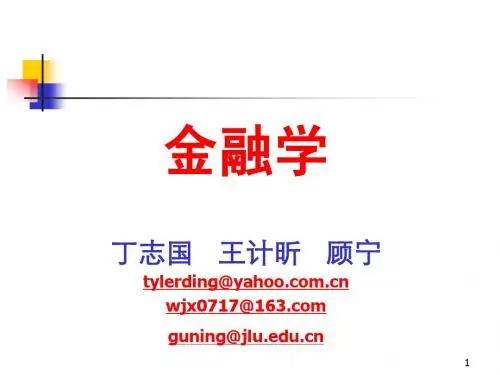
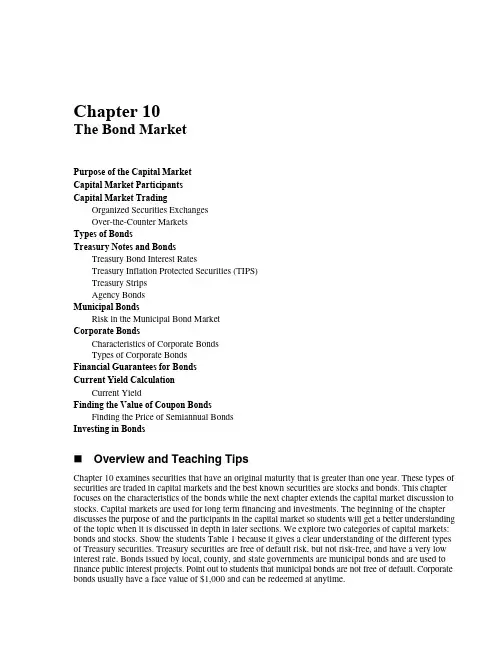
Chapter 10The Bond MarketPurpose of the Capital MarketCapital Market ParticipantsCapital Market TradingOrganized Securities ExchangesOver-the-Counter MarketsTypes of BondsTreasury Notes and BondsTreasury Bond Interest RatesTreasury Inflation Protected Securities (TIPS)Treasury StripsAgency BondsMunicipal BondsRisk in the Municipal Bond MarketCorporate BondsCharacteristics of Corporate BondsTypes of Corporate BondsFinancial Guarantees for BondsCurrent Yield CalculationCurrent YieldFinding the Value of Coupon BondsFinding the Price of Semiannual BondsInvesting in BondsOverview and Teaching TipsChapter 10 examines securities that have an original maturity that is greater than one year. These types of securities are traded in capital markets and the best known securities are stocks and bonds. This chapter focuses on the characteristics of the bonds while the next chapter extends the capital market discussion to stocks. Capital markets are used for long term financing and investments. The beginning of the chapter discusses the purpose of and the participants in the capital market so students will get a better understanding of the topic when it is discussed in depth in later sections. We explore two categories of capital markets: bonds and stocks. Show the students Table 1 because it gives a clear understanding of the different types of Treasury securities. Treasury securities are free of default risk, but not risk-free, and have a very low interest rate. Bonds issued by local, county, and state governments are municipal bonds and are used to finance public interest projects. Point out to students that municipal bonds are not free of default. Corporate bonds usually have a face value of $1,000 and can be redeemed at anytime.52 Mishkin/Eakins • Financial Markets and Institutions, Sixth EditionThe chapter concludes by showing how to compute the value of bonds. An example focuses specifically on valuing semiannual bonds. This valuation model can be used to show that interest-rate risk will affect the wealth of investors in bonds.Answers to End-of-Chapter Questions1. Investors use capital markets for long-term investment purposes. They use money markets, whichhave lower yields, primarily for temporary or transaction purposes.2. The primary capital market securities are stocks and bonds. Most of these are purchased and ownedby households.3. The primary market is for securities being issued for the very first time, and the issuer receives thefunds paid for the security. The secondary market is for securities that have been issued previously but are being traded among investors.4. The par value is the amount the issuer will pay the holder when the bond matures. The coupon interestrate is multiplied times the par value to determine the interest payment the issuer must make each year.The maturity date is when the issuer must pay the holder the par value.5. Treasury bills mature in less than 1 year, Treasury notes mature in 1 to 10 years, and Treasury bondsmature in 10 to 30 years.6. The risk that a bond’s price will change due to changes in market interest rates is call interestrate risk.7. Agencies that issue securities include Ginnie Mae (formerly the Government National MortgageAssociation), the Federal Housing Administration, the Veterans Administration, the Federal National Mortgage Association, and the Student Loan Marketing Association. The first four fund mortgage loans and the last funds college student loans.8. Firms like having the flexibility to adjust their capital structure by paying off debt they no longerneed. They also need to pay off debt to remove restrictive covenants. Call provisions permit both these actions at the issuer’s discretion.9. A sinking fund contains funds set aside by the issuer of a bond to pay for the redemption of the bondwhen it matures. Because a sinking fund increases the likelihood that a firm will have the funds to pay off the bonds as required, investors like the feature. As a result, interest rates are lower onsecurities with sinking funds.10. The list of terms of a bond is known as the indenture.11. Capital market securities may be sold in a public offering or in a private placement. In a publicoffering, investment bankers register the security with the SEC and market it through a network of brokerage houses. In a private placement, the firm or an investment banker sells the securities to a very limited number of investors, who each buy a large quantity.Chapter 10 The Bond Market 53Quantitative Problems1. A bond pays $80 per year in interest (8% coupon). The bond has 5 years before it matures at whichtime it will pay $1,000. Assuming a discount rate of 10%, what should be the price of the bond(Review Chapter 3)?Solution: $924.182. A zero coupon bond has a par value of $1,000 and matures in 20 years. Investors require a 10%annual return on these bonds. For what price should the bond sell? (note, zero coupon bonds do not pay any interest) (Review Chapter 3)?Solution:$148.643. Consider the two bonds described below:BondBABondMaturity 15 yrs 20 yrs10% 6%Coupon Rate(Paid semiannually)Par Value $1,000 $1,000a. If both bonds had a required return of 8%, what would the bonds’ prices be?b. Describe what it means if a bond sells at a discount, a premium, and at its face amount(par value). Are these two bonds selling at a discount, premium, or par?c. If the required return on the two bonds rose to 10%, what would the bonds’ prices be?Solution:a. Bond A = $1,172.92Bond B = $802.07b. Bond A is selling at a premiumBond B is selling at a discountc. Bond A = $1,000Bond B = $656.824. A 2-year $1,000 par zero-coupon bond is currently priced at $819.00. A 2-year $1,000 annuity iscurrently priced at $1,712.52. If you want to invest $10,000 in one of the two securities, which is a better buy? You can assumea. the pure expectations theory of interest rates holds,b. neither bond has any default risk, maturity premium, or liquidity premium, andc. you can purchase partial bonds.Solution: With PV= $819, FV= $1,000, PMT= 0 and N= 2, the yield to maturity on the two-year zero-coupon bonds is 10.5% for the two-year annuities, PV= $1,712.52, PMT= 0,FV= $2,000 and N= 2 gives a yield to maturity of 8.07%. The zero-coupon bonds arethe better buy.54 Mishkin/Eakins • Financial Markets and Institutions, Sixth Edition5. Consider the following cash flows. All market interest rates are 12%.Year 0 1 2 3 4Cash Flow160 170 180 230a. What price would you pay for these cash flows? What total wealth do you expect after 2½ yearsif you sell the rights to the remaining cash flows? Assume interest rates remain constant.b. What is the duration of these cash flows?c. Immediately after buying these cash flows, all market interest rates drop to 11%. What is theimpact on your total wealth after 2½ years?Solution: a. 234160170180230Price 552.671.12 1.12 1.12 1.12=+++= 1.555 1.5180230Expected Wealth 160(1.12)170(1.12)$733.691.12 1.12=×+×++= b. 234160170180230(1)(2)(3)1.121.12 1.12 1.12Duration2.50552.67+++== c. Expected Wealth = 1.5.5.5 1.5180230160(1.11)170(1.11)$733.741.11 1.11×+×++= Since you are holding the cash flows for their duration, you are essentially immunized from interestrate changes (in this simplistic example).6. The yield on a corporate bond is 10% and it is currently selling at par. The marginal tax rate is 20%.A par value municipal bond with a coupon rate of 8.50% is available. Which security is a better buy? Solution: The equivalent tax-free rate = taxable interest rate × (1 − marginal tax rate). In this case,0.10 × (1 − 0.20) = 8%. The corporate bond offers a lower after-tax yield given themarginal tax rate, so the municipal bond is a better buy.7. If the municipal bond rate is 4.25% and the corporate bond rate is 6.25%, what is the marginal taxrate assuming investors are indifferent between the two bonds?Solution: The equivalent tax-free rate = taxable interest rate × (1 − marginal tax rate). In this case,0.0425 = 0.0625 × (1 − X ), or X = 32%.8. M&E Inc. has an outstanding convertible bond. The bond can be converted into 20 shares of commonequity (currently trading at $52/share). The bond has 5 years of remaining maturity, a $1,000 par value, and a 6% annual coupon. M&E’s straight debt is currently trading to yield 5%. What is the minimum price of the bond?Solution: The price must exceed the straight bond value or the value of conversion (you will seewhy in the next question).If converted, the debt is worth $52 × 20 = $1,040.Assuming a 5% YTM is correct, the price of straight debt is computed as:PMT = 60; N = 5; FV = 1000; I = 5Compute PV ; PV = 1,043.29The bond must be trading for at least 1,043.29.Chapter 10 The Bond Market 55 9. Assume the debt in the previous question is trading at 1,035. How can you earn a riskless profit fromthis situation (arbitrage)?Solution:a. Short 20 shares of M&E at $52/share.Cash $1,0470*b. Purchase a convertible bond. ($1,0.35)$5c. Convert the bond to shares, and use to close short position.Assuming these transactions are completed simultaneously, you make a riskless profit of $5.*Typically, small investors cannot short stock and have use of the proceeds—the broker retains it as collateral. So, this doesn’t quite work. But the idea is correct.10. A 10-year, 1,000 par value bond with a 5% annual coupon is trading to yield 6%. What is the currentyield?Solution: The current price of the bond is computed as follows:PMT= 50; N= 10; FV= 1000; I= 6ComputePV; PV= 926.40The current yield = 50/926.40 = 5.4%11. A $1,000 par bond with an annual coupon has only 1 year until maturity. Its current yield is6.713% and its yield to maturity is 10%. What is the price of the bond?Solution:a. CY= 0.06713 = Coupon/Price, or Coupon = 0.06713 × Priceb. Price = (Coupon + 1000)/1.10.Substituting from (1), Price = (0.06713 × Price + 1000)/1.10Solve for Price, Price = $968.1712. A 1-year discount bond with a face value of $1,000 was purchased for $900. What is the yield tomaturity? What is the yield on a discount basis?Solution: 900 = 1000/(1 +YTM), or YTM = 11.11%YDB= (1000 – 900)/1000 × (360/365) = 9.86%13. A 7-year, $1,000 par bond has an 8% annual coupon and is currently yielding 7.5%. The bond canbe called in 2 years at a call price of $1,010. What is the bond yielding, assuming it will be called (known as the yield to call)?Solution: The current price of the bond is computed as follows:PMT= 80; N= 7; FV= 1000; I= 7.5ComputePV; PV= 1,026.48Using this, the yield to call is calculated as follows:PMT= 80; N= 2; FV= 1010; PV= 1,026.48ComputeI; I= 7.018%56 Mishkin/Eakins • Financial Markets and Institutions, Sixth Edition14. A 20-year $1,000 par value bond has a 7% annual coupon. The bond is callable after the 10th yearfor a call premium of $1,025. If the bond is trading with a yield to call of 6.25%, the bond’s yield to maturity is what?Solution: The current price of the bond is computed using the yield to call as follows:PMT= 70; N= 10; FV= 1025; I= 6.25PV; PV= 1,068.19ComputeUsing this, the yield to maturity is calculated as follows:PMT= 70; N= 20; FV= 1000; PV= 1,068.19I; I= 6.39%Compute15. A 10-year $1,000 par value bond has a 9% semi-annual coupon and a nominal yield to maturity of8.8%. What is the price of the bond?Solution: The price of the bond is computed as follows:PMT= 45; N = 20; FV= 1000; I= 8.8ComputePV; PV= 1,013.1216. Your company owns the following bonds:Value DurationBond MarketA $13million 2million 4B $18C $20million 3If general interest rates rise from 8% to 8.5%, what is the approximate change in the value of the portfolio?Solution: Portfolio duration = 2 × (13/51) + 4 × (18/51) + 3 × (20/51) = 3.09Δ Value =−Duration × (Δi/(1 +i)) × Original ValueΔ Value =−3.09 × (0.005/1.08) × $51 million = $729,583。